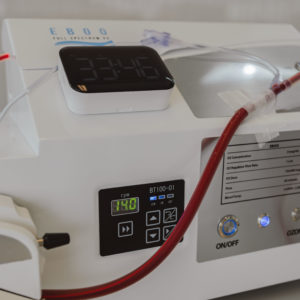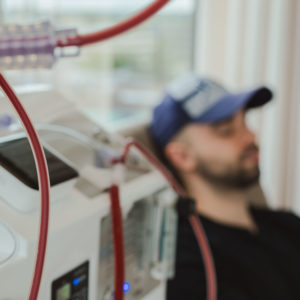9 min|Integrative
Unlocking Vitality: The Fundamental Secrets of Heart Health
Wellness, Heart Health, DiabetesBasics of Heart Health
The cardiovascular system, comprised of the heart, blood vessels, and approximately 5 litres of blood, keeps us alive. It transports oxygen, nutrients, hormones, waste, and immune cells throughout the body. Blood consists of blood cells, such as white blood cells, red blood cells, and platelets, as well as plasma (mostly water with a small percentage of proteins, glucose, minerals, carbon dioxide, and hormones).
The transport of blood throughout our body is vital; it ensures our tissues receive oxygen, delivers immune support if there is an infection, and delivers platelets to the site of wounds.Blood vessels are lined with a smooth layer of specialized cells known as endothelial cells. If our blood vessels are exposed to toxins such as cigarette smoke, high blood sugar levels, high blood flow (as in hypertension), and dyslipidemia, the endothelium is damaged.(1-3)
Following damage, components found in the blood such as white blood cells, triglycerides, calcium, and cholesterol rush to the site of damage to protect the blood vessel from further damage, similar to how a scab acts to protect the skin. If the exposure is chronic, this process continues, creating a build-up known as plaque that thickens the vessel wall, reducing its' ability to transport blood, and oxygen, to tissues.
Additionally, if the plaque dislodges, it can move to various areas of the body, leading to a block in an artery that feeds various tissues with oxygen. If this occurs in the artery that provides blood, and oxygen, to the brain, a stroke occurs. If this occurs in an artery that supplies blood to the heart, the result is a heart attack. The instigator of this entire process is the damage that occurs to the endothelium and the inflammatory process that occurs in response.(4)
What Does Cholesterol Have to Do With It?
Cardiovascular disease, like many conditions, is essentially inflammation gone wild, a normal process runs amok due to chronic exposure to factors that damage the endothelium.
Cholesterol: Friend or Foe?
Since cholesterol is present in plaques, many efforts to treat cardiovascular disease have focused on cholesterol, under the assumption that increased cholesterol led to heart disease.
These efforts gained momentum in the 1950s, after Dr. Paul Dudley White, chief physician to President Eisenhower, cited a research study completed by nutritionist Ancel Keys that purportedly showed a link between fat consumption and heart disease.(5) And thus, the “diet-heart hypothesis" - the theory that cardiovascular disease was caused by high dietary consumption of saturated fat - was born. A nutritional war entrenched in political and financial interests ensued, and while many scientists at the time were skeptical and suspicious of the role sugar may play in weight gain and heart disease, Keys theory gained momentum and ‘won out’. His study altered the landscape of cardiovascular medicine, leading to the vilification of dietary fat.
The Low-Fat Diet
By the 1960s, the American Heart Association was recommending a decrease in fat consumption, particularly limiting cholesterol and saturated fat, and replacing them with low-fat alternatives and seed oils; the low-fat diet was born.(6) Consuming fat provides a natural sense of satiety - feeling full and satisfied - and without fat in the diet, people were hungry. In an effort to avoid fat, they reached for carbohydrates, particularly refined carbohydrates, to try to fill up.(5)
This shift in nutritional recommendations was not matched with a decrease in cardiovascular disease and obesity; instead, the opposite occurred. Subsequent research showed cholesterol and saturated fat in the diet has virtually no effect on cholesterol in the blood in most of the population.(7,8)
Additionally, heart attacks can occur in people with cholesterol levels that are considered ‘within normal range’.(9) And replacing saturated fat in the diet with refined carbohydrates actually increases the risk of heart disease and worsens cardiometabolic health.(10,11) North America, decreased their fat consumption, France, where consumption of saturated fats and dietary cholesterol is high, maintained lower rates of cardiovascular disease, a phenomenon so intriguing to Western researchers, it gained the title the ‘French Paradox’.(12)
Cholesterol and You
For decades following the development of the “diet-heart hypothesis” (also called the fat hypothesis or lipid hypothesis), as efforts have aimed to decrease dietary fat, cardiovascular disease and its consequences (such as heart attack and stroke) have become one of the leading causes of death in North America.
In Canada, cardiovascular disease (CVD) is the second leading cause of death, with four Canadians who were diagnosed with CVD dying every hour.(13) According to most recent data, 8.5% of Canadians are living with heart disease.(14) In order to understand why the development of cardiovascular disease is not as simple as ’the cholesterol consumed becomes the cholesterol that clogs your arteries’, we need to know why we have cholesterol in our body in the first place.
The truth is, we need cholesterol.
It is found in every cell in our body, helping to produce the cell membrane; sex hormones such as estrogen, progesterone, and testosterone; vitamin D; and bile acids (a substance that aids in the digestion of fat). It also plays a major role in the membranes of cells in the brain and in the transmission of neurotransmitters.
Your liver produces most of the cholesterol in the body with the rest coming from the diet. If you eat more, the liver makes less; if you eat less, the liver will make more. Since blood is mostly water and cholesterol is fat soluble, it combines with proteins to be carried around the body. Depending on what it combines with, it may end up as HDL, historically called ‘good cholesterol’, implying the more HDL cholesterol, the better.
However, further research is showing that HDL can behave well, reducing inflammation, or poorly, depending on the individual.(15) LDL, often termed ‘bad cholesterol’. LDL has two subtypes, each of which behaves differently. Large, fluffy LDL particles may actually be quite benign, while small, dense LDL play a role in the development of cardiovascular disease.(16)
Apolipoprotein B, also known as apo B, a small, highly inflammatory cholesterol particle is of greatest concern. In low levels, it circulates and repairs damaged the endothelium. However, when the endothelium is chronically damaged, more Apo B is recruited and it begins to promote the deposition of oxidized LDL into the wall, leading to more inflammation and eventually, plaque. Apo B also promotes the formation of blood clots on top of the plaque, further thickening the deposition and narrowing the vessel.(17)
The Risks of Lowering Cholesterol
Since certain subtypes of cholesterol do appear to be linked to atherosclerosis, conventional medicine has aimed to decrease all cholesterol in an effort to decrease the risk of heart disease. In fact, for some, decreasing cholesterol can carry more risk than benefit. Cholesterol is an essential molecule for life. Naturally, when cholesterol levels are low, many biological processes are altered.
One study found men with low cholesterol were more likely to die prematurely from suicide(18); another found depression was more likely in men with low cholesterol.(19) An association between low cholesterol and violence has been observed.(20) Very recently, elevated levels of total cholesterol and LDL were found to be associated with lower rates of Parkinson’s disease.(21) Higher cholesterol also appears to be protective against infection due to the important role it plays in the immune system.(22)
Our misguided obsession with decreasing all cholesterol has led to the creation of cholesterol-lowering drugs known as statins. Statins work by inhibiting an enzyme that aids in the production of cholesterol; without this enzyme, cholesterol is not produced by the liver. The inhibition of this pathway not only inhibits synthesis of cholesterol, it also affects our ability to produce CoQ10, an essential nutrient found in every cell in the human body.
We Cannot Live Without CoQ10
The heart contains the highest concentration of CoQ10 and it is essential for the activity of this great muscle, as well as all other muscles in our body. A depletion of Coq10 can lead to muscle cramps, weakness, fatigue, loss of muscle mass, muscle spasms, and numbness, all noted side effects of statins.(23) Since the brain also requires cholesterol for communication, another possible side effect of statins are cognitive and memory problems, a potential complication is a subset of the population may be particularly vulnerable due to genetic variants.(24) With cholesterol acting as a precursor for all sex hormones, statin drugs may affect levels of hormones such as testosterone.(25)
Statins have also been linked to depression and anxiety; is it theorized that this is due to altered serotonin receptor binding.(26) The list goes on and on - as more research is compiled, we’re developing a greater understanding of why cholesterol is essential for our well-being, and how detrimental it can reduce it. The biggest question, given all of these risks - are statins even effective at reducing rates of heart attack or stroke? In an extensive meta-analysis of statin use in people with pre-existing heart disease, 96% saw no improvement at all; 1.2% saw their lifespan extended by preventing a fatal heart attack, 0.8% prevented a stroke.(27) In patients with no pre-existing heart disease, 98% saw no improvement over the course of 5 years; 1.6% prevented a heart attack and 0.4% were helped by preventing a stroke.(28)
In an additional meta-analysis, statin use was not associated with a decreased risk of death from all causes in patients with pre-existing high risk of cardiovascular disease.(29) In the eight-year-long ALLHAT trial, death rates did not vary between the statin group and non-statin group; researchers found slightly lower rates of heart attacks and stroke in the statin group but the difference was not considered significant.(30)
Metanalysis suggests that you would need to treat 60 people for 5 years to prevent a heart attack, or 268 people for 5 years to prevent a stroke, in people with pre-existing heart disease. (27) These statistics, combined with the potential side effects, complications, and costs associated with statins are a reason to give pause and discuss with your doctor as to whether they are the best option for you.
It’s clear that there is more to heart disease than simply cutting out dietary fat and taking a statin drug. With this acting as the predominating method of treatment, cardiovascular disease has remained one of the most pervasive killers in the Western world.
In the next article, we’ll dive into the causes of inflammation at the root of cardiovascular disease, and the natural ways to prevent and reverse cardiovascular disease, without drugs. (Diabetes: The Real Deal - Part 1)
Are you looking for support with improving your health and longevity?
Book a consultation with one of our experienced Naturopathic Doctors today!
REFERENCES
- https://www.ncbi.nlm.nih.gov/pmc/articles/PMC2517732/
- https://www.ncbi.nlm.nih.gov/pubmed/18230954
- https://www.sciencedirect.com/science/article/pii/S1568997210001540
- http://www.annualreviews.org/doi/abs/10.1146/annurev.pathol.1.110304.100100
- https://www.theguardian.com/society/2016/apr/07/the-sugar-conspiracy-robert-lustig-john-yudkin
- http://www.heart.org/idc/groups/heart-public/@wcm/@fc/documents/downloadable/ucm_475005.pdf
- https://academic.oup.com/ajcn/article/91/3/535/4597110
- https://www.ncbi.nlm.nih.gov/pubmed/19852882
- http://www.ahjonline.com/article/S0002-8703(08)00717-5/abstract
- https://www.ncbi.nlm.nih.gov/pmc/articles/PMC4744652/
- http://openheart.bmj.com/content/1/1/e000032
- https://www.ncbi.nlm.nih.gov/pmc/articles/PMC1768013/
- https://www.canada.ca/content/dam/phac-aspc/documents/services/publications/diseases-conditions/heart-disease-maladies-coeur-eng.pdf
- https://www.canada.ca/content/dam/phac-aspc/documents/services/publications/diseases-conditions/heart-disease-fact-sheet/heart-disease-factsheet-eng.pdf
- https://www.ncbi.nlm.nih.gov/pubmed/17169248
- https://jamanetwork.com/journals/jama/article-abstract/374290?redirect=true
- https://www.ncbi.nlm.nih.gov/pmc/articles/PMC5310383/
- https://www.sciencedirect.com/science/article/pii/S0022395608002525?cc%3Dy
- https://www.sciencedirect.com/science/article/pii/0140673693925569
- https://www.ncbi.nlm.nih.gov/pubmed/9575009
- https://www.medscape.com/viewarticle/881576
- https://www.drsinatra.com/low-cholesterol-levels-can-hurt-your-immune-system
- https://www.webmd.com/cholesterol-management/side-effects-of-statin-drugs#2-4
- https://www.scientificamerican.com/article/its-not-dementia-its-your-heart-medication/
- https://www.ncbi.nlm.nih.gov/pmc/articles/PMC3621815/
- http://pubs.acs.org/doi/abs/10.1021/bi100276b
- http://www.thennt.com/nnt/statins-for-heart-disease-prevention-with-known-heart-disease/
- http://www.thennt.com/nnt/statins-for-heart-disease-prevention-without-prior-heart-disease/
- https://jamanetwork.com/journals/jamainternalmedicine/fullarticle/416105?resultClick=3
- https://www.nhlbi.nih.gov/science/antihypertensive-and-lipid-lowering-treatment-prevent-heart-attack-trial-allhat
Related Articles

9 min|Dr. Alex Chan
EBOO for Chronic Inflammation: A Natural Approach for Systemic Relief
Regenerative Medicine, EBOO Therapy
9 min|Dr. Alex Chan
EBOO Therapy for Autoimmune Conditions: Exploring the Potential Benefits
Autoimmune Disease, Regenerative Medicine, EBOO Therapy


